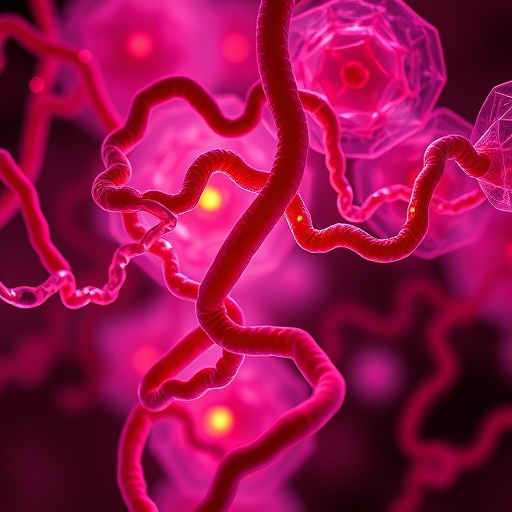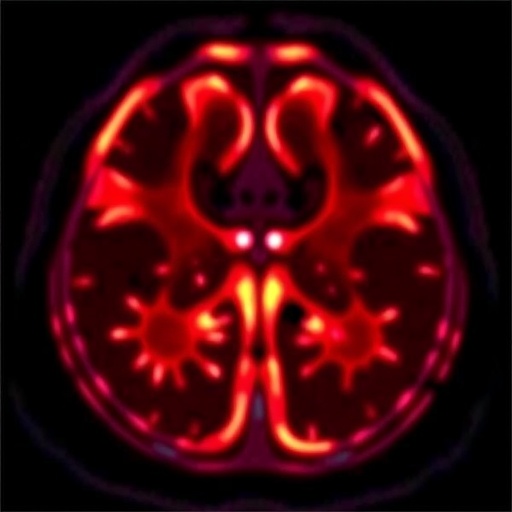Colorectal cancer (CRC) remains a formidable challenge in oncology, representing one of the most prevalent and deadly malignancies worldwide. Despite advances in treatment, patients diagnosed with late-stage CRC face dismal prognoses, with five-year survival rates plummeting to as low as 14% for stage IV disease. At the heart of this aggressive pathophysiology lies a complex tumor microenvironment (TME), a dynamic network in which cancer-associated fibroblasts (CAFs) emerge as major influencers of tumor progression, metastasis, and resistance to therapy. New research has begun unraveling the molecular intricacies by which CAFs regulate the tumor matrix, specifically highlighting the metabolic reprogramming that fuels collagen overproduction in CRC.
The extracellular matrix (ECM) is a crucial component of the TME, and collagen comprises approximately 90% of this scaffold. Excessive collagen deposition not only mechanically fortifies tumors but also forms a formidable physical barrier against immune surveillance and pharmacologic intervention. Central to collagen’s structural integrity is glycine, the most abundant amino acid within its triple-helix configuration, yet the mechanisms ensuring sufficient glycine supply in the tumor milieu remained elusive until now. Recent scientific investigations have illuminated a pivotal metabolic shift in CRC-associated fibroblasts, whereby de novo glycine synthesis drives enhanced collagen production, aggressively remodeling the ECM to favor cancer progression.
To dissect this phenomenon, researchers isolated primary fibroblast populations from human colorectal tumors and adjacent normal tissues, establishing cultures of CAFs and normal fibroblasts (NFs) for comparative analysis. Metabolomic profiling of these cells revealed a pronounced reprogramming in amino acid metabolism specific to CAFs. Notably, glycine concentrations were nearly doubled within these activated fibroblasts compared to their normal counterparts, a finding corroborated by elevated glycine levels in conditioned media derived from CAF cultures. Intriguingly, this glycine augmentation was attributed predominantly to heightened endogenous synthesis rather than extracellular uptake, directing attention toward the enzymatic machinery governing this pathway.
Further molecular characterization uncovered that the glycine biosynthetic pathway enzymes—phosphoglycerate dehydrogenase (PHGDH), phosphoserine aminotransferase 1 (PSAT1), phosphoserine phosphatase (PSPH), and serine hydroxymethyltransferase 2 (SHMT2)—were upregulated at both transcriptional and protein levels in CAFs. These findings reflect a coordinated enhancement of the serine-glycine pathway, enabling sustained production of glycine to meet the biosynthetic demands of collagen assembly. PHGDH, catalyzing the rate-limiting step of this pathway, emerged as a particularly critical enzyme, linking metabolic reprogramming to structural ECM remodeling.
Delving into the signals orchestrating this metabolic remodeling, the study leveraged conditioned media from aggressive SW480 colorectal cancer cells and identified a soluble factor responsible for modulating fibroblast metabolism. Transforming growth factor-beta 1 (TGF-β1), a cytokine well known for its multifaceted roles in tumor biology, was secreted at substantially higher levels by CRC cells relative to CAFs. Treatment of fibroblasts with exogenous TGF-β1 recapitulated the metabolic activation seen with cancer cell-conditioned media, including upregulation of glycine synthesis enzymes and increased collagen production. Conversely, pharmacologic blockade of TGF-β signaling via the receptor I inhibitor SB431542 or neutralizing antibodies abrogated these effects, firmly establishing TGF-β1 as the linchpin in this cross-talk.
The therapeutic implications of these findings are significant. With PHGDH positioned at the nexus of this metabolic axis, the authors explored the potential of targeting this enzyme to disrupt collagen overproduction in CAFs and thereby modulate the tumor microenvironment. Both RNA interference-mediated knockdown and selective pharmacological inhibition using NCT503 substantially diminished TGF-β1-induced collagen I and IV synthesis. Western blot and immunofluorescence analyses confirmed the downregulation of these critical ECM components, indicating that PHGDH inhibition can effectively incapacitate the metabolic support system CAFs utilize to reinforce tumor infrastructure.
The relevance of these discoveries extends beyond in vitro cultures to human colorectal cancer tissues. Employing histological techniques such as Masson’s trichrome staining and immunohistochemistry, the study demonstrated robust collagen I/IV deposition co-localizing with elevated PHGDH expression and CAF marker alpha-smooth muscle actin (α-SMA) in tumor specimens compared to normal adjacent tissues. These in situ observations affirm the clinical significance of metabolic remodeling in the tumor stroma and underscore PHGDH as a viable biomarker and therapeutic target.
To further substantiate their findings, the research team analyzed public datasets derived from CRC patient samples and associated stromal populations. Dataset PRJNA717755 and PRJNA319481 revealed positive correlations between expression levels of TGF-β receptor I (TGF-βR1), enzymes involved in de novo glycine synthesis, and collagen gene expression. This convergence of bioinformatics, biochemical assays, and pathology affirms a conserved regulatory axis driving ECM remodeling through metabolic manipulation in CRC.
Taken together, this comprehensive study elucidates a novel mechanism by which colorectal cancer cells manipulate their microenvironment to foster tumor progression and resistance. By secreting TGF-β1, cancer cells induce a metabolic shift in CAFs, activating de novo glycine synthesis pathways that support excessive collagen production. This not only structurally remodels the tumor stroma but also contributes to the pathophysiology of CRC by establishing a protective niche that impairs immune infiltration and drug efficacy.
Importantly, the identification of PHGDH as a central mediator offers a promising avenue for therapeutic intervention. Inhibitors targeting this metabolic enzyme have the potential to dismantle the tumor-supportive ECM by curtailing glycine-dependent collagen synthesis, thereby attenuating tumor aggressiveness and possibly enhancing responsiveness to existing treatments. This approach signifies a paradigm shift, moving beyond targeting cancer cells alone to incorporating strategies aimed at stromal metabolism and ECM dynamics.
Future investigations may explore the combinational potential of PHGDH inhibitors with immune checkpoint blockers or chemotherapies to overcome the physical and immunosuppressive barriers imposed by the collagen-rich TME. Moreover, expanding this research to diverse tumor types could unveil broader applications for targeting amino acid metabolism in CAFs. The elucidation of such metabolic crosstalk reinforces the importance of understanding tumor-stroma interactions and heralds a new frontier in cancer therapeutics.
In summary, this groundbreaking research unravels the complex interplay between colorectal cancer cells and their microenvironment, emphasizing the crucial role of de novo glycine synthesis in CAF-mediated collagen production. Through meticulous biochemical and histological analyses complemented by bioinformatics, the study lays a robust foundation for exploiting metabolic pathways as therapeutic targets. Targeting PHGDH in CAFs emerges as a compelling strategy to disrupt tumor-stroma communication, dismantle the collagenous fortress safeguarding tumor cells, and improve clinical outcomes in colorectal cancer.
Subject of Research: Metabolic reprogramming of cancer-associated fibroblasts to support collagen synthesis in colorectal cancer via de novo glycine synthesis induced by tumor-derived TGF-β1.
Article Title: Colorectal Cancer Cells Drive Collagen Production in Cancer-Associated Fibroblasts via TGF-β1-Induced de novo Glycine Synthesis: PHGDH as a Promising Therapeutic Target
News Publication Date: 24-Aug-2025
Web References: http://dx.doi.org/10.1002/mog2.70037
Image Credits: Yinglan Zhao & Xiao Du
Keywords: Colorectal cancer, cancer-associated fibroblasts, extracellular matrix, collagen synthesis, glycine metabolism, de novo glycine synthesis, phosphoglycerate dehydrogenase (PHGDH), transforming growth factor-beta 1 (TGF-β1), tumor microenvironment, metabolic reprogramming, therapeutic target, fibrosis
Tags: cancer-associated fibroblasts rolecollagen production in cancercolorectal cancer researchECM and immune evasionextracellular matrix remodelingglycine synthesis in tumorslate-stage colorectal cancer prognosismetabolic reprogramming in cancerPHGDH as a therapeutic targetTGF-β1 signaling pathwaytherapeutic targets in oncologytumor microenvironment dynamics





